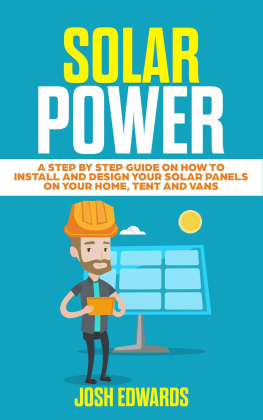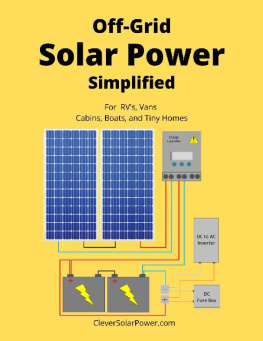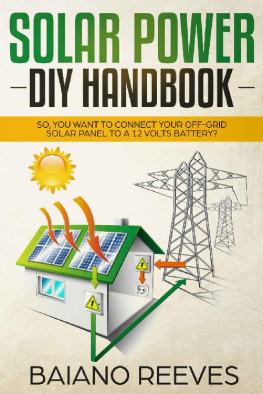OFF GRID
MOBILE SOLAR POWER INSTALLATION
IN 1 HOUR
A Step by step Guide to Design and install 12 Volts Solar Power System on Vans, RVS, Boats and Mobile Homes
Larry Barone
Copyright
Larry Barone
ChurchGate Publishing House
USA | UK | Canada
Churchgate Publishing House 2020
All rights reserved. No part of this publication may be reproduced, stored in a retrieval system or transmitted in any form or by any means, electronic, mechanical, photocopying, recording, and scanning without permission in writing by the author.
While the advice and information in this book are believed to be true and accurate at the date of publication, neither the authors nor the editors nor the publisher can accept any legal responsibility for any errors or omissions that may be made. The publisher makes no warranty, express or implied, with respect to the material contained herein.
Printed on acid-free paper.
Printed in the United States of America
2020 by Larry Barone
Contents
Introduction to Electricity
This modest explanation is for those who are confused or have little knowledge of electricity. As someone who has little or no understanding of electricity, this section will help to give you an idea of what electricity is and how it works.
If you are an expert, you will have to forgive certain simplifications. This is because the aim is to allow everyone to find their way around their electrical installation.
Electricity is a form of energy. It is often described as a phenomenon linked with the mobility or immobility of charged particles. Natural phenomena, such as lightning, were already observed from way back. But for a very long time, electricity terrified men who saw it as a manifestation of divine anger or supernatural powers.
It was not until the late 16th century that it began to be studied by scientists to understand its mechanisms and establish laws. Their successive work made it possible to artificially create electricity by transforming various sources of energy.
Today, this electricity is produced by power plants that transport and distribute it to consumers. Like the fire of the time of prehistoric men, electricity has changed the lives of humanity. It has become essential to everything that makes up our daily life.
What makes up electricity
Electricity just like every matter is made up of atoms. Each atom is made up of:
A central nucleus which is an assembly of protons and neutrons. Protons carry positive charges and neutrons do not carry charges and are therefore neutral (hence their name);
A set of electrons which rotate very quickly around the nucleus. Electrons carry negative charges.
Normally, an atom includes as many electrons as protons, so as many positive charges as negative charges. These charges often balance, making the atom electrically neutral. However, an electron may be added to those of an atom (by friction with another atom for example). This can cause the balance to break and the atom becomes negative. In the same way, an electron can be removed from an atom, causing it to become positive. Electricity results from the movement of these electrons.
The Forms of electricity
Electricity naturally occurs in various forms. These forms include:
The nerve impulses of certain living organisms which emit electric discharges (as for the eel);
The static electricity created by rubbing or bringing different materials into contact, for example between hair and wool when removing a sweater;
Lightning which is formed from an electric discharge between the Earth and a cloud. Sometimes, it occurs only between two clouds.
It can also be created artificially in power plants by transformation:
Sources of fossil fuels like coal, petroleum or natural gas, resulting from the decomposition in the rock of plants during millions of years;
Sources of fossil energy such as uranium, the atoms of which can be broken down to release heat and energy;
Renewable energy sources such as water, wind, sun, heat from the Earth, or biomass that nature constantly renews.
Measuring electricity
In terms of measurements, four well-known parameters make it possible to evaluate an electric current. These measurements include voltage, intensity, power, and energy. To understand these physical measures, you can compare the circulation of electrons in a conductor to that of water in a pipe.
The electrical voltage is comparable to the pressure of the water in the pipe when the tap is closed. It is the accumulation of charges in the conductor, which results in the appearance of an electrical potential. Called voltage, this potential is expressed in volts (V).
The intensity of the electric current can be compared to the flow of water passing through the pipe when the tap is open. This flow of electrons in the conductor is expressed in amperes (A).
The power of the water jet corresponds to the result of the combined pressure and flow. Likewise, electrical power is the product of "intensity" and "voltage". Its unit of measurement is the watt (W). It is more commonly expressed in kilowatt (kW).
Finally, energy evaluates the consumption of electricity, which is to say the power used during a given period. It is measured in kilowatt-hours, that (kWh).
Electric Circuits: Serial vs Parallel
The electrical circuit can be designed in parallel or series depending on the specificity of the electrical installations connected to it. But in practice, it is the parallel circuits which are used to carry out domestic cabling. An assembly with multiple advantages, this cabling technique is much more appreciated than the series circuit.
The difference between the parallel or serial circuit
Electrical circuits intended to supply various installations with electricity can be designed in two ways, either in parallel or in series. The parallel circuit is a mounting method that supplies currents to its parallel components at the same voltage, but the current is not the same. In other words, it is an electrical distribution technique whose branches share pairs or triple common nodes. This type of circuit is most commonly used in domestic electrical networks.
As for the series circuit, it is a principle of mounting cables that allows the different elements of the electrical installation to have an individual load. On this type of circuit, each device or point of use is continuously supplied with a load that is exclusive to it. With a single sequence and a single series, the current flows in one direction until all the elements of the circuit are supplied. The difference between the parallel or series circuit, therefore, lies in the mounting and operating technique.
The multiple advantages of the parallel circuit













